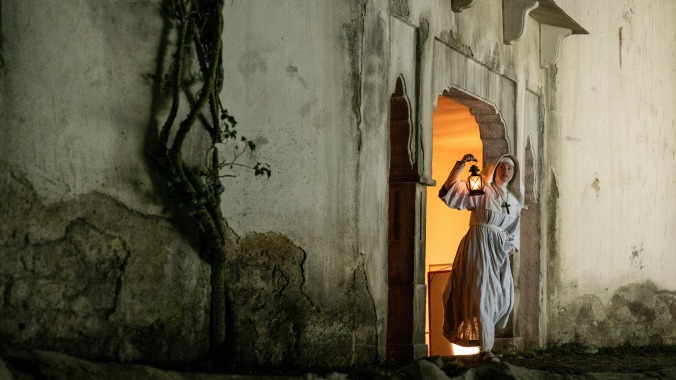FX’s Black Narcissus remake is pretty, but uninspiring


The opening credits for FX’s latest miniseries pointedly read, “based on the novel by Rumer Godden.” Which is true: Black Narcissus was indeed a novel before it was adapted for the screen by Michael Powell and Emeric Pressburger. That’s like pointing out that The Godfather is based on a novel—the movie has so far eclipsed the book that acknowledging the source material, but not the film, feels like a deliberate slight. And the 1947 version is admittedly outdated, not least for its casting of a white woman, Jean Simmons, as an Indian character. But if you’re going to reclaim and rework something like Black Narcissus, a tale of repressed desire in the stunningly gorgeous (maybe a little too gorgeous) Himalayas, you might as well do something interesting with it.
Black Narcissus is a co-production between FX Networks and the BBC, whose history is littered with perfectly adequate literary adaptations: Take the 1985 version of Bleak House, which is notable for being neither the first nor the most popular TV adaptation of Dickens’ novel despite featuring the late Diana Rigg in the starring role. Rigg’s career goes out on a similarly middle-of-the-road note with Black Narcissus, in which she plays Mother Dorothea, the lead nun who sends Sister Clodagh (Gemma Arterton) to serve as Sister Superior of a new convent in the remote Himalayan palace of Mopu. With Last Night In Soho still on the shelf awaiting the reopening of movie theaters worldwide, this is now Rigg’s second-to-last screen role, a deflating compromise that’s emblematic of this well-shot, but rote miniseries.
Danish cinematographer Charlotte Bruus Christensen, who shot The Girl On The Train and A Quiet Place, directs the new Black Narcissus, which—perhaps predictably, given that there’s a DP in the directors’ chair—is quite enamored with the scenery on the series’ Nepalese location shoots. Powell and Pressburger’s version was shot at London’s famous Pinewood Studios, and actually traveling to the Himalayas for the new version does allow for an expansion of the nuns’ world beyond the palace walls to include both a nearby village and the sweeping valley below. (That being said, the famous bell tower atop a vertigo-inducing cliff seems to have been enhanced with CGI.) The production design and set dressing take similar advantage of their surroundings, making visually striking use of intricate Nepalese embroidery and weaving. But in terms of lighting, competing with a film that won an Academy Award for its breathtakingly luminous cinematography is a fool’s errand—and Christensen, wisely, doesn’t really try.
Beyond its setting, however, Black Narcissus is pretty unremarkable. Joining Sister Clodagh at the new convent are Sister Briony (Rosie Cavaliero), the cook and household manager; Sister Philippa (Karen Bryson), the gardener; Sister Blanche (Patsy Ferran), the teacher; and Sister Ruth (Aisling Franciosi), the young, troubled nun. They join local caretaker Angu Ayah (Nila Aalia); “7 to 11-year old” translator Joseph Anthony (Soumil Malla); and lower-caste orphan Kanchi (Dipika Kunwar), who’s entrusted to the convent’s care by the region’s British colonial representative and man-about-town Mr. Dean (Alessandro Nivola). And that’s just the immediate household: The wealthy general who owns the place, Toda Rai (Kulvinder Ghir) and his teenage son Dilip Rai (Chaneil Kular) also come around often, fueled by their shared obsession with becoming respectable in the eyes of British colonial society.
Expanding the story to a three-hour limited series would seem to create an opportunity for writer and executive producer Amanda Coe to let the audience get to know each of these characters better. But, with the exception of a storyline that plays up the haunted-house aspects of the tale—yes, this is a Black Narcissus with jump scares—for the most part, the emphasis is still on Arterton’s Sister Clodagh and the lustful memories (and rivalries) sparked by the ruggedly masculine Mr. Dean. In this updated cable-TV version, that includes some self-flagellation in front of a statue of Jesus, as well as some salty insults exchanged between Clodagh and the similarly infatuated Sister Ruth. But the edgier aspects of the adaptation don’t really amount to much, and neither do the soap-opera ones.
We’re left with plot points from the novel explained in more detail than in Powell and Pressburger’s film, a novelistic but unexciting take on the material. If you’ve seen the original film and have some questions, but not the time to read the novel, then this relatively quick three-hour experience may be useful. If you’re not familiar with the source material at all, then Black Narcissus is marvelous drama, an impressionistic and haunting tale of sensual madness in a setting that sparks the imagination. Struggling against the harsh headwinds of expectation, however, it never quite manages to ascend to new heights of inspiration.